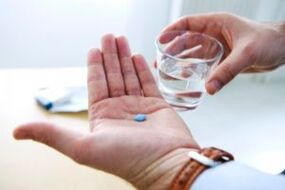Erectile dysfunction refers to a multifactorial psychosomatic syndrome that occurs in men of all ages, characterized by typical symptoms of erectile dysfunction necessary to satisfy sexual desire.
After the age of 50, impotence in men can be an indicator of dysfunction of many organs. Erectile dysfunction significantly reduces a person's quality of life.
Impotence is defined as the inability to achieve a full and stable erection, maintain it, and ensure successful sexual intercourse. The concept of "impotence" is considered obsolete, but to this day it continues to be used in everyday life and does not lose its relevance.
It is common to use the term "erectile dysfunction" in urological practice.
After the age of 50, the frequency of potential decline among men reaches 25%. Complaints of erectile dysfunction peak in the sixth decade.
Reasons for weak potential and impotence in the 50s

After 50 years, male potential is weakening for many reasons. Accumulated health problems are reflected not only in the manifestations of diseases of the heart, blood vessels, gastrointestinal tract, joints, but also in the functioning of the reproductive system.
The main causes of decreased potency in men over 50 are vascular pathologies, psychological disorders and diseases of the nervous system. In addition, prostate adenoma in men over the age of 50 is often considered a cause of erectile dysfunction.
According to international studies, there are several main causes of impotence in older men:
- Vascular: atherosclerosis, arterial hypertension, impaired fat metabolism (increased cholesterol levels, low-density lipoproteins, high atherogenic index). These vascular factors lead to the pathological functioning of the cavernous sinuses of the penis, narrowing of the arteries and veins, which prevents them from filling with normal blood, which prevents erection. For normal potential in men, dilation of the vessels of the cavernous bodies of the penis is required, which is not possible with an increase in blood pressure, vascular pathology identified by atherosclerotic plaques in the abdominal aorta. Progressive varicose veins, which affect the small pelvic vessels, also cause impotence in men over the age of 50.
- Neurogenic: central and peripheral. Central ones include parkinsonism, multiple sclerosis, cerebral infarction, and epilepsy. Peripherals include other diseases, especially pathologies of the nervous system caused by diabetes, alcoholism, polyneuropathy. These diseases cause a gradual deterioration of the trophism of the tissues of the genital organs, degenerative processes in the nerve fibers.
- Urology: prostate adenoma, chronic prostatitis.
- In connection with the provision of iatrogenic medical care: damage to the nerves of the rectum, testicles, prostate, bladder during surgery.
- Traumatic: pelvic injuries, damage to the genital arteries, urethra, spinal cord, fractures of the pelvis.
- Endocrine: obesity, insufficient or excessive thyroid function, type 1 and 2 diabetes mellitus, pituitary gland pathologies, adrenal glands (Itsenko-Cushing's syndrome).
- Medications: medications that lower blood pressure, restore heart rhythm, diuretics, antidepressants, antiallergics, tranquilizers, antiandrogens, some hormonal agents (estrogens, analogues and antagonists of pituitary hormones, antiandrogens).
- Anatomical, ie anomalies or diseases of the penis: Peyronie's disease, hypo and epispadias, fractures of the genitals, acute curvature of the penis.
- Psychological: sexual arousal disorder due to two types of stimuli. Incomplete libido is a violation of intimacy. Situational type refers to the obvious effect of stress on a person's body and personal relationship with a partner. Situational impotence, as a rule, is not a pathology and requires the solution of personal problems, after which erectile function is restored.
As a result of sexual arousal, a nerve impulse along the reflex arc of a healthy person causes a stable erection. This process is based on the release of nitric oxide, the source of which is the cells of the inner lining of the blood vessels of the penis.
For an erection to occur and continue, the nerve impulse must reach the smooth muscle cells that make up the blood vessels of the penis. As a result, the nerve endings interact with the endothelium (inner layer of blood vessels) and nitric oxide is released.
In turn, nitric oxide activates an enzyme that helps release calcium ions from cells. Smooth muscle cells relax and an erection occurs.
The full functioning of the reflex arc, which provides normal potential, is possible only if it maintains a healthy state of its connections: nerves, blood vessels, endocrine glands.
The pathogenesis of potential disorders in men over 50 years of age is associated with a decrease in the release of nitric oxide by the cells of the penile vessels. As a result, the cascade of reactions that ensure a complete erection is disrupted.
Many organs and systems are involved in the process of building normal potential in a 50-year-old man. A number of diseases that an adult man in his sixties inevitably encounters lead to the failure of one of the potentially reflex arc connections.
Almost every man experiences episodes of impotence at the age of 50, but depending on the severity of the dysfunction of various organs and systems, erectile dysfunction can be situational (temporary) or permanent.
Important
Persistent impotence in a 50-year-old man requires a systematic and comprehensive approach to treatment. A one-sided approach to the treatment of impotence leads to a temporary improvement in the situation.
Diagnosis of impotence

Not all men consult a urologist or sex therapist to address their potency problems. As a rule, members of the stronger sex use folk remedies to improve potency or independently buy popular drugs in pharmacies.
A comprehensive diagnosis of impotence in men over the age of 50 consists of the following steps:
- ultrasound of the small pelvic organs, including transrectal ultrasound of the prostate, pharmacodoplerography of the vessels of the penis;
- visual test of erotic stimulation;
- monitoring of penile tumors, including at night;
- palpation of the prostate through the rectum;
- cavernozography, spongiography;
- CT and MRI;
- study of the functions of the endothelium of the vessels of the penis (coronary angiography with acetylcholine, study of the flow-dependent dilatation of the brachial artery in a sample with narrowing, laser Doppler flowmetry, study of the tone of peripheral arteries);
- biochemical blood test, glucose tolerance test, assessment of blood lipid spectrum;
- ultrasound of the abdominal organs;
- blood test for hormones (male and female sex, thyroid and adrenal hormones);
- blood test for prostate specific antigen;
- Cardiovascular studies (veloEKG, ultrasound).
An important point in the diagnosis of the root causes of impotence in men over 50 is the consultation of a sexologist and psychologist. In addition, tests are widely used to identify potential pathologies that are widely available in the network, such as ICEF.
How to increase potential after 50

After the age of 50, the treatment of impotence in men is often carried out conservatively, including with medication and the intervention of a psychologist.
First of all, for the success of the treatment of impotence in adult men, it is necessary to treat or restore as much as possible the pathologies of the heart and blood vessels, endocrine system, diseases of the liver, kidneys, bladder. and the prostate gland.
In men over 50 years of age without chronic pathology of the internal organs, it can be corrected by a potentially popular means - phosphodiesterase inhibitors (PDE).
PDE inhibitors are the most effective and fast-acting drugs in male sexual pathology. These include:
- vardenafil - duration of action is 5-12 hours;
- sildenafil - duration of action 4 hours;
- tadalafil - duration of action 36 hours.
The drug is used one hour (half an hour) before sexual intercourse. You should know that there should be a minimum of excitement for an erection when taking the funds of this group. The dosage is on average 50 mg, but can be reduced to 25 mg at a time or increased to 100 mg.
However, such drugs have a fairly wide range of side effects on the lungs and heart, because the drug does not only affect the endothelium of the vessels of the penis.
With the help of PDE inhibitors, an increase in potency in men after the age of 50 is achieved by influencing the main mechanism of the pathogenesis of erectile dysfunction: an increase in the concentration of nitric oxide. In addition to this group of agents, NO-synthase activators are used to increase nitric oxide content.
Many men are concerned about the fact that alcohol can be used to relax and increase the chances of a stable erection, how to increase potency after the age of 50 with the help of drugs, and how they can be combined with alcohol.
If a man does not abuse alcohol and does not suffer from severe pathologies of the cardiovascular system, popular means to increase potency can be taken with alcohol.
In addition to PDE inhibitors, popular treatments for impotence include:
- Testosterone remedies. Potency recovery in men after the age of 50-60, when testosterone production by the testicles is reduced, can be used preparations of male sex hormones.
- Prostaglandins injected into the tissues of the penis. The means improve blood flow, normalize the filling of blood vessels and arteries.
- Alpha-blockers, the action of which is based on the dilation of the penis and small pelvic vessels.
The potential can be increased with folk remedies such as Eleutherococcus, Ginseng, Aralia, pumpkin seeds, nuts, celery, honey, ginger. In addition, dietary supplements are widely used.
In the case of chronic diseases, it is very difficult to improve the potential after 50 years, so it is recommended to use additional physiotherapeutic methods, especially acupuncture and electrophoresis.
The potential can also be increased by mechanical means, especially by using a vacuum pump for the penis.
The fight against obesity and alcohol dependence is important in the treatment of impotence.
As you know, fat cells in the male body are considered a source of female sex hormones, which disrupts the hormonal balance, leading to pathologies of the prostate gland and sexual dysfunction. The source of natural estrogens is beer. Men over the age of 50 should drink beer no more than once a week.
To lose no more than 5 kg per month, you need to lose weight gradually. Moderate exercise and diet are recommended. Intensive, spontaneous and intense training in the gym will not restore the potential, but will aggravate the situation.
A dosing approach to dynamic loads, nutritional correction will allow you to overcome impotence without harming the body.














































